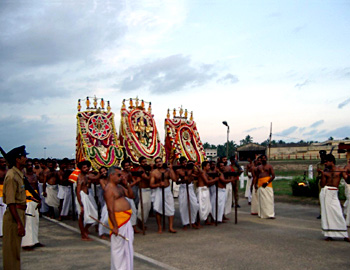 There are mainly two annual utsavams at the Padmanabhaswami temple, one in the month of Meenam (March-April) and the other in Thulam (September-October). Both are 10-day festivals with the inaugural flag-hoisting (Kodiyettam) ceremony on the first day, the Pallivetta (hunting) ceremony and procession on the 9th day and the arattu, the ritual bathing of the deities on the 10th day. On all these days, within the temple, there are elaborate pujas and ceremonial processions.
There are mainly two annual utsavams at the Padmanabhaswami temple, one in the month of Meenam (March-April) and the other in Thulam (September-October). Both are 10-day festivals with the inaugural flag-hoisting (Kodiyettam) ceremony on the first day, the Pallivetta (hunting) ceremony and procession on the 9th day and the arattu, the ritual bathing of the deities on the 10th day. On all these days, within the temple, there are elaborate pujas and ceremonial processions.
The vetta (hunt) and arattu (immersion) processions are held twice a year at Trivananthapuram represent the universal truth that a spectacle will be complete only if the actors and the audience are brought together. The two processions are two phases of one transaction that is full of universal truth expressed with impressive art.
The idea of the procession is that Lord Vishnu as the protector of the universe sets out to hunt and destroys the demon of destructiveness. The vetta procession simulates the progress of Vishnu to the point when he runs the demon to earth in a forest. The climax of the myth takes place at a spot in front of the Sundaravilasam Palace in Trivananthapuram fort, where two hundred years ago, an attack was made on the life of Maharaja Marthanda Varma, whose devotion to the Lord found unique expression in his dedication of the state to Lord Padmanabha.
The famous arattu procession takes place on the 10th day of the utsavam in the late afternoon. The images of Sri Padmanabha, Lord Krishna and Narasimha are carried out from the temple along the three-mile road to the edge of the vast Arabian Sea, at Sankhumukham, escorted by members of the princely family and armed police contingents, with temple accessories. At sunset, as per custom the deities are initially bathed in the sea after appropriate pujas. An illuminated procession escorts the purified images back to the temple.
The two processions are perhaps the most exoteric in symbolising spectacularly the triumph of good over evil and the extirpation of that which obstructs the spiritual life and attainment of purification and peace through the destruction of the passions. And if the temple is a representation of the cosmos, such ceremonials, carried out through the art of symbolical presentation, anticipate the final withdrawal of the external universe into the being of Brahman.











